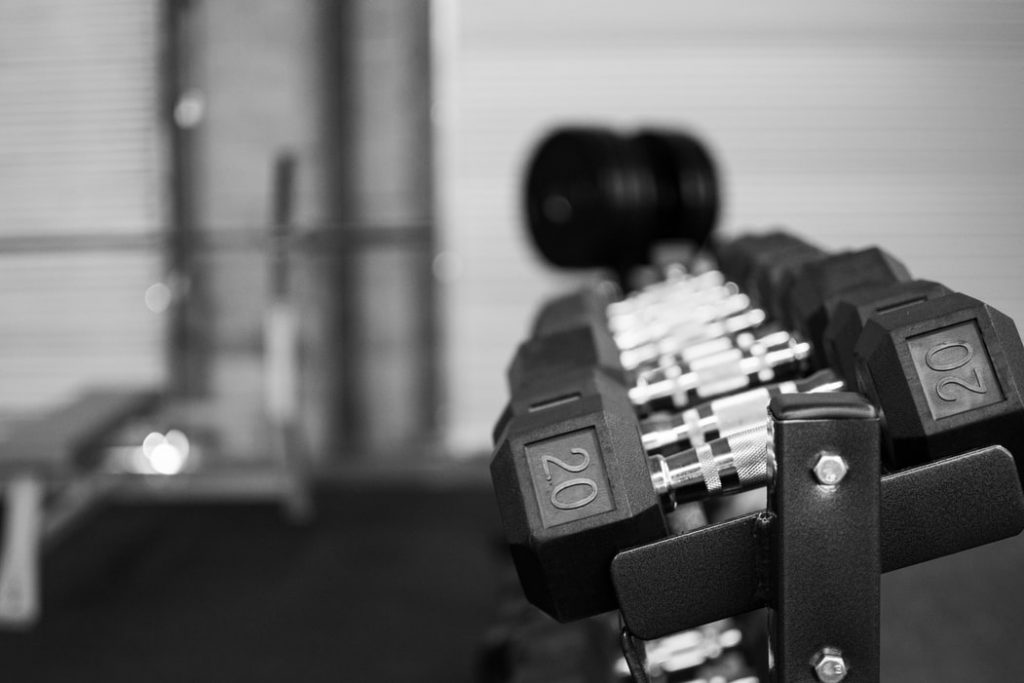If you’re just starting on a weight loss or muscle building journey, you want to focus on getting to the gym and working out regularly rather than worrying about:
- Strength workouts
- Power workouts
- Endurance workouts
Each type of workout is essential, but you should focus on a standard routine before diving into the logistics of strength, power and endurance. All three types of exercises are necessary for “whole-body health,” but you’ll find many people focus on one or two types of workouts.
Why?
Everyone has their own goals.
If you want to build muscle, a power or strength training workout is likely what you’ll focus on. But if you want to maintain your strength over lengthy activities, an endurance workout plan may be a better choice.
Let’s look at all three workout types, how to perform them and which you should be doing.

What is a Strength Workout?
When performing a strength training workout, you’re trying to move as much weight as possible for a specific amount of reps. A powerlifting workout is all about strength training. For example, you might train at your 1 rep max (RM) to increase your deadlift.
In short, strength training focuses on the force needed to overcome resistance.
How To Workout for Strength?
A strength training routine can be adjusted to meet your goals. If you want to build strength, you certainly can with a 10 rep routine, but when you’re trying to add mass and increase your one-rep max, your routine may be:
- 5 repetitions for 5 sets
- 3 repetitions for 3 sets
- 1 repetition for 3 / 5 sets
When trying to build strength, the key most important thing is to find your 1 repetition maximum. For example, if you can bench 200 pounds for one rep, this is your maximum. Finding this number is crucial because you’ll use it to develop your routine.
You might perform your 5 x 5 routine at 80% RM, your 3 x 3 routine at 90 RM and then your 1 RM should be as heavy as you can go.
How does this translate to more strength?
When you’re breaking down your muscle fibers with more weight, you will build more muscle than if you focused on light load resistance. An excellent study on high load vs. low load resistance called Effects of Low- vs. High-Load Resistance Training on Muscle Strength and Hypertrophy in Well-Trained Men was conducted in 2015 and found that:
- High load resistance led to an increase in maximum strength of 6.5%
- Low load resistance led to an increase in maximum strength of 2%
Remember that muscle endurance didn’t increase for the high load group as it did for the low load group, but we’ll cover this in greater detail below.
Strength training exercises should focus on major muscle groups. A strength program should include a mix of activities, but compound exercises provide the most muscle engagement. You’ll burn more body fat and add more lean muscle mass by including major muscle groups into your training plan.
How Long Should a Strength Training Workout Be?
Your routine length depends on how many exercises you’re performing. For example, if you’re a beginner, you may want to perform three strength exercises per strength session, while someone advanced may be doing five or six exercises each workout.
But you’ll spend most of your workout session resting. Building strength demands high energy expenditure, so to maximum benefits and reach fitness goals, slot in rest periods in your fitness routine.
Most experts suggest resting for 2 to 3 minutes between strength training sets. If you’re doing a 5 x 5 routine, this means you’ll spend 10 – 15 minutes resting per exercise.
Many people can’t dedicate hours a day to exercise, so a good 45 to 60-minute workout will suffice.
Due to the heavy weight involved in this type of strength training, you’re at a higher risk of injury. Try to maintain perfect form to minimize injury risk.
But if you want to know how many weeks you should be training for strength, an 8 to 12 weeks is great before switching up to power or endurance for a few weeks. You want to keep your muscles growing, and growth means keeping your muscles guessing.
Note: A study on rest between sets, using two to five-minute rest periods, did not find a difference in neuromuscular and hormonal response. If you only need two minutes, don’t prolong the rest period because it won’t benefit you.
How Long Does Muscle Synthesis Continue After a Strength Training Workout?
A 1995 study on muscle protein synthesis found the following:
- Synthesis remained more than double normal synthesis rates 24 hours after heavy resistance exercise
- Synthesis rapidly declined to near baseline 36 hours after a workout
The synthesis process pushes your proteins 50% higher in the first four hours after your workout ends and 109% higher after 24 hours.
Quick note
It’s essential to warm up before a workout if you’re focusing on strength or power because you’ll use a heavier weight. If you want to exercise for strength or power, be sure to warm up to avoid muscle injuries and strains.

What is a Power Workout?
Power is vital, although a little bit confusing to understand. This is because so many people, myself included at one point, thought that power and strength were the same. But they’re slightly different.
When you focus on power, you’re focusing on overcoming resistance in the shortest amount of time possible.
For sports athletes, power is necessary because it uses:
- Force
- Velocity
When you need to engage in high-speed movements, a power workout will make these rapid movements.
Interestingly, studies on power workouts have shown very positive results for older adults, although studies also show that power training is more effective than traditional training. A study from 2005 shows that a progressive resistance training routine can help older adults in numerous ways:
- Offer rapid strength gain
- Increase in power
- Enhance physical performance
Focusing on power can make standing up from chairs or off the floor easier for older adults and younger ones. But, of course, power training is being combined with strength training in a clinical setting to maximize benefits.
Increased reaction time, cardiovascular endurance and even better coordination and balance are associated with power training.
How can you adapt your workout routine to include explosive power?
How To Workout for Power?
Remember, it’s essential to do two main things for power: train for strength and speed. You’ll be working on your fast-twitch muscle fibers when you’re engaging in a power routine, and this often leads to three main types of exercises performed:
- Plyometric. High-intensity and often called “shock training,” plyometrics involve jumping or hopping. You might see athletes jumping side to side to improve their explosiveness with these movements. Broad jumps or adding in a box jump would be included.
- Ballistic. Movements in a ballistic training routine may include throwing a medicine ball overhead and includes releasing weight.
- Dynamic. A form most people engage in which requires lifting light weights in the 50% to 60% 1RM range as quickly as possible for 4 to 5 reps. Olympic lifts are a good option here.
Maintaining proper form and resting between sets are essential when engaging in a dynamic workout. Rest will often be between 3 and 4 minutes, but it can be more if necessary.
You can use free weights, kettlebells, bodyweight, resistance bands, resistance tubing and even medicine balls in a dynamic workout.
Explosive power exercises can focus on the upper body or lower body. In addition, power moves often include compound exercises to maximize athletic performance and strength. Deadlifts, a vertical jump, depth jump or a power clean are all examples of exercises to add to your power training.
If you’re training for power, you should focus on the following:
- Weight ranges of 0% to 70% of your 1RM
- Repetitions between 2 and 6
Speed is integral in your routine, so you may want to time yourself for a specific duration. For example, let’s assume that you’re training with 20-second sets. Naturally, you’ll want to squeeze as many reps into this time as possible, even if that means you hit 10 reps.
Ideally, you’ll reach 4 to 6 reps in this timeframe.
Depending on the exercise chosen, you may want to perform 2 to 3 sets of each exercise. If you find that you’re hitting 7 or 8 reps fast, increase the weight.
How Long Should a Power Workout Be?
Power workouts are similar to strength in that you’ll want to train for 45 to 60 minutes at a time. However, due to the stress on the nervous system, it’s recommended that you perform 2 to 3 power workouts maximum per week.
Your nervous system needs two to three days to repair.

What is an Endurance Workout?
If there’s any form of exercise that affects the brain, it’s an endurance workout routine. You’ll push your limits – I hope – by creating an endurance workout that leaves your muscles on fire at the end of your session.
In terms of mental torture, these routines are intense.
You’ll perform high rep ranges, use light weights, and rest for 30 seconds to a minute between each set. Muscular endurance allows you to perform movements or tasks for long periods without getting as tired.
If you need to lift 40-pound bags of rocks for an hour, endurance training will help you become more efficient than strength training.
Endurance activities should be added to training sessions. However, heavy weight training shouldn’t be the only form of exercise that you perform. Building a training program that incorporates light weight and basic endurance exercise is crucial for functional training.
How To Workout for Endurance?
What exercises are endurance workouts? They’re not aerobic exercise nor are they cardio exercise, although they can get your heart rate soaring.
Endurance workouts are high-intensity workouts that focus on lighter weight and more repetitions. Building muscular endurance requires repetitions in the 12 to 20+. Personally, I like to perform at least 12 to 15 reps, but I’ll continue my repetitions until my form breaks down or I can no longer lift the weight.
Sometimes, I’ll hit 30+ reps, and other times I’ll hit 21 – every time, I’m going as hard as I can.
You’ll want to perform 3 or 4 sets of each exercise you perform. Examples of endurance exercises for a back routine:
- 4 sets of 15 to 30 reps of rows
- 4 sets of 15 to 30 reps of lat pulldowns
- 4 sets of 15 to 30 reps of deadlifts
Of course, you can add in more exercises if you want to build an endurance workout that works on your weaknesses and goals.
How Long Should an Endurance Workout Be?
Speed is the name of the game with endurance workouts. How many sets are in an endurance workout? It depends on your rest period, repetitions, sets and number of exercises. Let’s assume the following:
- 3 exercises chosen
- 4 sets each exercise
- 15 reps per set
Let’s assume it takes 1 second up and 3 seconds down for each repetition and 30 to 60 seconds of rest. This would mean completing every set would take around 1 minute for 15 reps plus an additional 30 to 60 seconds of resting.
Each exercise may take up to 8 minutes to complete all four sets of a single exercise.
You’ll also need to switch machines or weights, and you’ll easily be in the 30-to-40-minute range or higher if you add in more exercises. Endurance activity should be performed in a short period of time to minimize rest.
Try to perform your reps as fast as possible and completely forget about your traditional workout speed. Your speed and minimal rest make every session a challenging workout. Minute rest periods are great because minute recovery allows you to rest just long enough to go on to your next set.
Endurance workouts should start with beginner exercises and advance as your skill levels improve.
How Long Does Muscle Synthesis Continue After an Endurance Training Workout?
Endurance training also produces a different protein and adaptive response than strength training, according to a 2018 study. In addition, the study found that both regular and irregular bouts of endurance training led to higher levels of:
- Skeletal muscle growth
- Muscle protein synthesis
But while the body needs more protein after an endurance workout, there’s little information on if muscle synthesis improves significantly.
Strength vs. Power vs. Endurance Workout: Which Should You Do?
All of them. We all have our goals, and if you’re a powerlifter, you know that strength will be your primary focus. You want to make sure that you can push or pull through as much resistance as possible. But then you have people like Julius Maddox (Irregular Strength) trying to break the world record for bench press.
Maddox holds the world record for bench press at 782, but he’s pushing to reach 800 pounds.
You’ll see him doing 700+ pounds for 1 or 2 reps and then 661 pounds for 5 sets. He focuses on power and strength.
But for well-rounded fitness, you should mix in strength, power and endurance training. You can make up your own routine of periodization where maybe you do 4 weeks of strength training followed by a week or two of endurance training.
Some routines are also changed weekly, for example:
- Week 1 strength
- Week 2 endurance
- Week 3 power
- Week 4 hypertrophy (8 to 12 reps)
If you want the best general health possible, you need to mix strength workouts, power workouts and endurance workouts into your routine. You can also slot in certain workout types on certain days.
Let’s assume that on Monday, you’re dead. You’re not able to push 80% of the weight you did Friday, and it’s just an off day. Perform an endurance workout to mix things up.
You want to keep your body guessing to stop plateaus from occurring. However, even an elite athlete needs to change their training sessions up.
There are also athletes and fitness experts following what is known as undulating periodization. What does undulating periodization mean? It’s a type of workout schedule that changes from one day to the next.
It’s all about flexibility with this type of periodization.
Monday, you’re feeling weak, boom do an endurance workout. Tuesday, do a hypertrophy workout and Wednesday, focus on your strength and power workout routines. You need to hold yourself accountable so that you’re not always doing a hypertrophy or endurance workout, and if you do, you’ll reap the rewards.
Since you’re keeping your body guessing from one day to the next, you’ll develop more strength faster, according to a 2002 study. The study found, over four weeks, participants that altered their training every day experienced more strength gain than those who didn’t.
If you’re trying to decide whether you want to focus on strength, power, endurance or hypertrophy, add them all into the mix for the best results.

